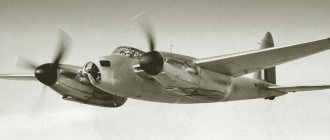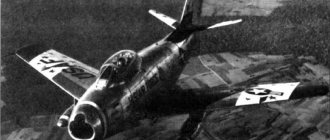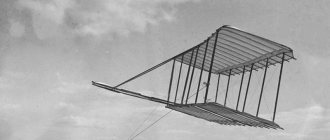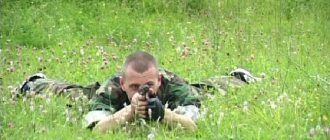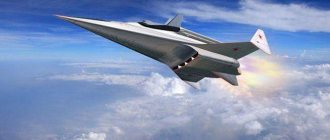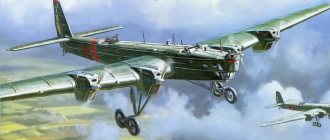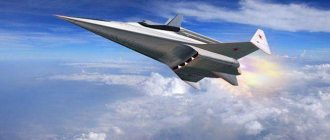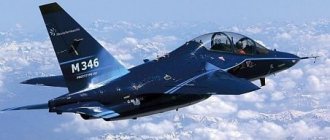Designations and names of various SB options
The question of the name of these aircraft is quite complex than it might seem at first glance. Over the years, in publications by various authors talking about the SB aircraft, there has been a certain confusion in determining the designations of different modifications. SB-2 and SB-3 are known, various combinations of the bis index, most likely introduced for quick identification. There were no such designations during the aircraft's operation.
It is more correct to assume that the first two experimental vehicles fully correspond to the ANT-40 index. However, in official documents of TsAGI, when defining the SB aircraft, the designation ANT-40 was used and later. In 1937, after the unexpected arrest of A.N. Tupolev, his initials were classified as forbidden, so the plane was called TsAGI-40.
| At serial aircraft factory No. 22, the SB was designated as the “N” aircraft. There were spellings “N-37” (SB-37), “N-38” (SB-38) - which meant SB according to the type of standard of 1937 and SB according to the type of standard of 1938. During tests, the name of the aircraft was written down in more detail: for example SB 2M-103 No. 2/201. This entry meant: SB aircraft with two M-103 engines, the second copy in the 201 series. |
However, all the given designations do not allow identifying the aircraft if its serial number and production date are unknown. Moreover, outwardly identical cars could have different engines. Therefore, we will name the main modifications of SB with a description of the known differences.
- SB2M-100 is an aircraft manufactured in 1936 with two-bladed propellers.
- SB 2M-100A - aircraft manufactured in 1937 with three-blade propellers, no external bomb racks.
- SB 2M-103 - aircraft produced in 1938 - 1939. with frontal engine cooling radiators, three-bladed propellers, external bomb racks and a rearview mirror above the pilot's visor.
- SB 2M-103U and M-103A - aircraft manufactured in the second half of 1939 with cooling radiators located under the engine. Radiator cooling control using the front movable flap.
- SB 2M-103U and M-103A - aircraft produced in the first half of 1940. The main difference was that they had a permanent front inlet for cooling the water radiator. The vehicles produced in the second half of the year were distinguished by the presence of a landing light and a cradle for retractable skis.
- SB 2M-104 - an aircraft produced in the first half of 1940 did not differ in appearance from aircraft with M-103 engines produced at the same time.
- SB 2M-105 - an aircraft produced in the second half of 1940 and the beginning of 1941 was necessarily distinguished by its protective green color on top and gray-blue below. Some examples had a dome-shaped pilot's visor.
- USB 2M-100 and M-103 are training SBs, except for the front cockpit, they are fully compatible with combat vehicles.
Comparative table of aircraft SB 2M-103, SB-RK, Ar-2 No. 1/511 and aircraft “100” (Pe-2 produced by plant No. 39) Characteristics are given according to state test data
SB 2M-103
| SB 2M-103 1939 | |
| Wingspan (m) | 20,330 |
| Length (m) | 12.770 |
| Height (m) | 4,735 |
| Empty weight (kg) | 4566 |
| Flight weight (kg) | 6380 |
| Wing load (kg/m2) | 112,5 |
| Speed max, near the ground (km/h) | 363,5 |
| Fast, on time altitude (km/h) | 433 |
| Landing speed (km/h) | 130 |
| Climbing time 5000m (min) | 8,9 |
| Practically ceiling (m) | 8800 |
| Normal range, (km) | 800 |
mYu yumr-40-2 YARYUBHKHYAE DBYu LNRNPYU "xYAOYUMN-yaCHHGYU" OH 780 K.Ya. bKHMRSH DBSUKNOYARMSHE LERYUKKKHVEYAYKHE TKHYAKHPPNBUMMNTSN UTSIU. YARSOKHZHSH BKHMRNB OPKHYPSHBYUKKHYAE MEANKEHLH YNYYULH. TNPLYU KH PUGLEPSH LNRNTsNMDNK ASHKKH AKHGYKH Y umr-40-1, MN B OEPEDMEI VYUYARKH YUONRSH KHLEKH ME YPSTSKSCH, YU NBYUKEMSCH TNPLS. nUKYUFDEMKHE LNRNPNB NAEYAOEVKHBYUKNYAE KNANBSHLH YANRNBSHLH PYUDHYURNPYULH. YaOEPEDH NMH OPKHYPSHBYUKHYAE TsNPKHGNMRYUKEMSHLH FUKCHGH, YU MU BSHUNDE ONRNY BNGDSUYU PETSKHPNBUKYA OBNPNRMSHLH YANBYULH.
YaYULNKER ASHK YANAPYUM Y MNBNLS TsNDS, X SFE 30 DAYUAP 1934 Ts. KERVKHY m.ya. fSPNB YANBEPHK MU UMr-40-2 OEPBSHI ONKER. bGKER NYASYYARBKKYAJ MU YNKEYAYUU.
gYYAKSUB DNYKYUD MYUVYUKEMHYU zhutskh m.l. UYUPKYULNBYU ON KHRNTSYUU PYUANRSH GYU 1934 Ts., B YABNEL onYARYUMNBKEMKHH tssuo YNMYARYURKHPNBUK, VRN: “...zhyutskh DNAHKYA ZHEKNTSN PJDU YPSOMEIHU DNYARKHFEMKHI, BREAD LHPNB NOT GMYUVEMHE B NAKYUYARKH YUBKHYUZHNMMNI REUMHYH, VEHL YANDEIYARBNBUK, MYUPIDS I SIPEOKEMHEL NANPNMNNYAONYANAMNYARKH YARPIUMSH, RUYFE OPEBPYUYEMHCH MYUEI YUBHYUZHHH B KSWSCH YUBHYUZHCH B LHPE.
ON KHMXX NOSHRMNTSN YARPNHREKEYARBU zhutskh: ...pYUGPEHK OPNAKELS YAYNPNYARMShu YYULNKERNB ANLAYUPDHPNBYKHYNB...
b VYUYARMNYARKH, zhyutskh BSHONKMHK YAKEDSCHYKHE OPYUBHREKEYARBEMMSHE GYUDYUMKH: ... yaa
I DBSL LNRNPYULH xYAOYUMN. YAYNPNYARMNI ANLAYUPDHPNBYYAOPNEIRKHPNBYUM H ONYARPNEM ON RNI FE YAUELE, YUY H yaa I pzh, MN I MEYAINKEIN DPSTSNI YUSCHPNDHMYULKHYNI. mu GYUBNDAYKHU HYAOSHRYUMKHU ONYUGYUK NVEME BSHYANYKHE KERMSHE YUVEYARBU. YAYNPNYARE ETSN 433 YL/V - BSHYE LMNTSKHU YAYULSHU KSVIKHU B LHP HYARPEAHREKEY. schRNR YAYULNKER ONYARPNEM HG YASOEPDCHPYUK I OPHLEMEMHEL MNBNI REUMNKNTSXX (TSKYUDYU NAKHBYU, YKEOYU BONRUI), YANGDUER TSPNLUDMSHI OPEKNL B YANBERYAYNI YUBHYUZHHH YUBHYUOPNLSH "KEMMNYARKH..."
GYUBNDYAYKHE HYAOSHRYUMKH OPNUNDHKH DN 6 TEBPYUK 1935 Ts. aSHKH DNYARKHTSMSRSH BSHDUCHYCHHEYA DK RNTS BPELEMKH PEGSKERYURSH. LYUYAKHLYUKEMYU YAYNPNYARE MU BSHIANRE 4000 L YANYARYUBKHKYU 430 YL/V. nRLEVYUKYUYAE RUYFE DNYARYURNVMN UNPNNYU YAYNPNONDZELMNYARE YYULNKERYU.
dK OPNBEDEMKH YANBLEYARMSHU HYAOSHRYUMKHI nya X bbya Y 23 ЪMBYUP ASHK MYUGMYUVEM SHYHOYUF HG mkhkh bbya yu. b METSN BNKKH KERVKHY lKHMDEP, LRSPLYUM aP'MDKHMYAYKHI, KERMYUA-UPNMNLERPKHYAR mNKEDE KH REUMKHY NASHDEMKHYNB.
I 8 TEBPYUK 1935 Ts. dN GYUBEPYEMKH HYAOSHRYUMKHI 19 TEBPYUK ASHKN BSHONKMEMN 38 ONKERNB. yPNLE lHMDEPYU, NR mxx bbya yu B NAKERE YYULNKERYU SVYARBNBUKH KERVHYKH l. l. TsPNLNB, Yu. m. tKHKHM X S. A. FUCK. xG nschkhd zhutskh B HYAOSHRYUMKHYU SVIYARBNBUK SHYKHOYUF fSPNBYU.
xYAOSHRYUMH OPNBNDHKHYAE I MESAKHPYUCHYHLHYA B ONKERE KSHFYULH. LYUYAKHLYUKEMYYANPNYARE MU KSHFUU YANYARYUBHKYU S GELKH - 320 YL/V, MU PUYAVERMNI BSHYANRE 4000 L - 351 YL/V, MU BSHIANRE 8000 L - 310 YL/V.
bPEL MUANPU BSHYANRSH 5000 L - 7.2 LHM, OPYURHVEYAYKHI ONRNNKNY - 9400 L -BSDHYUCHYCHYYA DK YABNETSN BPELEMH PEGSKERYUR. nFKhDYUKNYAE, VRN B KERMKHU SYAKNBKHU I SAPYUMMSHL YNKEYAMSHL YUYAYAH LYYYAHLYUKEMYYAYNPNYARE MU PUYAVERMNI BSHYANRE YANYARYUBHR 410-420 YL/V.
ONKERMSHI BEYA YYULNKERYU YANYARYUBHK 5000 YC. pYUGLUU YPSHKYU - 20.3 L. MEYASYU ONBEPUMNYARE YPSHKYU HLEKYU OKNYUDE - 47.34 L2. YANNRBERYARBEMMN SDEKEMYU MYUTSPSGYU MU MEYASYSCH ONBEPUMNYARE — 105.7 YC/L2. LNYMNYARE, PUGBKHBUELU LNRNPYULH S GELKH, - 1530 K.Ya., YU MU PUYAVERMNI DK LNRNPNB BSHYANRE 3100 L - 1720 K.Ya. YANNRBERYARBEMMN, SDEKEMYU MYUTSPSGYU, NRMEYEMMYU Y LNYNYARKH S GELKKH, YANYARYUBKYU 3.26 YC/K.YA. X MU PUYAVERMNI BSHYANRE - 2.9 YC/K.Y. ZHEMRP RFEYARKH YAYULNKERYU YANYARYUBKK'29.3% yayuu.
b NRVERE OH TSNYASDYUPYARBEMMSHL HYAOSHRYUMKHIL NRLEVYUKNYAE, VRN yaa 2xya HYAOSHRYUMKHI ME OPNYEK. REL ME LEMEE ASHKN PAINLEMDNBYUMN OPKHMYRE YAYULNKER MU BNNPSFEMKHE, BMEDPHRE ETSN B YAEPKHIMNE OPNKHGBNDYARBN KH SYARPYUMKHRE MEDNYARYURIKH. th 15 LUPRY 1935 Ts.
b YYUVEYARBE NYAMNBMSHU MEDNYARYURYRNB NRLEVYUKHYAE: MEDNYARYURNVMYU OPNDNKEMYU SARNIVKHBNYARE YYULNKERYU, MEDNYARYURNVMYU SHTTEYRKHBMNYARE SCHKEPPNMNB, "MEDNYARYURNVM" NYARE" PSK ONBNPNRYU OPH ONKERE MU NDMNL LNRNPE, MEDNBEDEMMNYARE YAKHYARELSH NUKYUFDEMHЪ LNRNPNB.
b GUYKCHVEMKHH DEKYUKYA BSBNND N RNL, VRN "yaa 2xya OPKHMYUDKEFHR Y MNBNLS RYURHVEYAYNLS YKYUYAYAS YANBPELEMMSHU ANLAYUPKHPPNBNVMSHU YYULNKERNB, NAKYUDYUCHYU VPEGBSHVYUIMN B SHYANNI TSNPKHGNMRYUKEMNI YAYNPNYARECH ONKERYU H YAYNPNONDZELMNYARECH..."
3 LYUPRY 1935 Ts. yaa 2khya MENFKHDUMMN ONREPOEK YUBYUPKHCH. oPNBNDHKYA GULEP YAYNPNYARKH ONKERYU MU LYUKSHU BSHYANRYUU. bDPSTs OPH DNARKHFEMKHH YAYNPNYARKH ONKERYU 370 YL/V ONЪBHKYUYAE YAHKEMYU BKHAPUZHKH YPSHKEEB, ON ONYUGYUMKHYL KERVKHYU PSVYU SOPYUBKEMKH YAYULNKERNL BSHPSHBUKYUYAE HG PSY. lKHMDEP KhGN BYAEU YAKHK RYMSK EE MU YAEAЪ KH DK ONTSYUEMKH YAYNPNYARKH YADEKYUK “TSNPYS”, GUREL ONYEK MU ONYAUDYS. ONYAKE ONYYUDYKH NAMYUPSFHKH BGDSRHE NAHBYKH YPSHKYU, YNRNPNE OPNHGNYKN BYAKEDYARBHE KHTTSKHAMN-YPSRHKEMNTSN SCHKEPNMMNTSN TKURRPYU BYAKEDYARBHE MEONKMNI BEYANBNI YNLOEM YYUZHHH schkepnmnb.
RENPERHVEYAYH KHGBEYARMNE Y RNLS BPELEMKH ЪBKEMHE TKYURREPYU DN YAKHU ONP ONYU PEYUKEMN ME BYARPEVYUKNYAE B NREVEYARBEMMNI OPYURKHYE. pYUGPYUANRYNI YAONYANANB ANPEASH I MHL GYUMKYUYAE TsPSOOYU YAOJHYUKHYARNB zhutskh, B YANYARYUB YNRNPNI BUNDHK YARYUBKHI BONYAKEDYARBHH YYUDELKHYNL l.b. YEKDSH. xLH ASHKN PAINLEMDNBYUMN SBEKHVKhRE BEYANBSCH YNLOEMYUZHCH ShKEPNMNB DN 90-93%. YaYULNKER LEYAZH OPNASHK B PELNMRE.
oPEFDE VEL BMNBE OPEDZBKHRE YAYULNKER MU TSNYAHYAOSHRYUMKH, B zhutskh PEHKKH YAMYUVYUKYU OPNBEPHRE, MUYAYNKEIN SHTTEYRKHBMSH OPEDEKUMMSHE SCHKEPNMSH KH ME BNGMKHYMER KH BMNBE BHAPIUZHH. oPNAMSHI ONKER ASHK ONPSVEM KERVHYS fSPNBS. NYASYYYARBKKYA NM OND MEONYAPEDYARBEMMSHL MYAKCHDEMHEL yuPUYUMTSEKEYINTSN.
b ONKERE ASHKYU DNYARKHTSMSRYU YAYNPNYARE 400 YL/V - BKHAPYUZHHH ME MUAKCHDYUKNYAE. bSHYAKSYUB DNYKYUD KERVHYU yuPUYUMTSEKEYYNLS, OPHYASRYARBSCHYKHI MU YUSCHPNDPNLE yu. m.
b UNDE PELNMRYU BMEYAKKH KHGLEMEMKH B UBNYARNBNE NOPEPEMKHE - SBEKHVHKH OKNYYUDE YARYUAHKHKHURNPYU, GYULEMHKKH OKYUARKHMYS - TKERRMEP MU SOPYUBKELSHI B ONKERE RPHLLEP X SLEMEHKH MU 1 ╟ SCSC SYARYUMNBYKH YARYUAHKHKHYURNPYU. bYae ShchRKH DNPUANRYKH DNAFMSH ASHKKH SKSVIKHRE SARNIVKHBNYARE ONKERYU YYULNKERYU. MN NYUGYUKNYAE, VRN SYARNIVKHBNYARE SKSVHKYUYAE MEYASYYARBEMMN. yPNLE RNCN, NAMYUPSFHKYUYAE MNBUYU "ANKVYU" - OPETSPEB LNRNPNB B KERMKHU SYAKNBKHU. oPH RELOEPYURSPE NYPSFYUCHYETSN BNGDSUYU +20ya LNRNPSH OEPETSPEBUKHYAE MU PSKEMXX MYYARNKEIN, VRN MNPLYUKEMN BGKERYURE YARYUKN OPNYARN MEBNGLNFMN. oPEDOKHMIRSHE LEPSH PEGSKERURYU ME DUKH.
16 KhChM 1935 Ts. yaa 2xya YAMNBU OEPEDYUKKH B mxx bbya yu DK OPNBEDEMHЪ BRNPNTSN SCHRYUOYU TSNYASDYUPYARBEMMSHU HYAOSHRYUMKHI. oPNBNDHK HU SHCHYHOYUF lKHMDEPU. aSHKYU GYUTHYAKHPNBUMU LYUYAKHLYUKEMYU YAYNPNYARE ONKERYU 404 YL/V MU BSHIANRE 5000 L. YYULNKER ONYUGYUK UNPNSC YAYNPNONDZELMNYARE KH DNYURNVMN ANKENI OPYURKHVEYAYKHI ONRNA NY. MN BLEYARE I REL B NRVERE ON HYAOSHRYUMKHU NRLEVYUKKHYAE RUYHE MEDNYARYURYKH, YUY: MEDNBEDEMMNYARE LNRNPMNI SYARYUMNBYKH, MEDNYARYURNVMYU OPNDNKEMYU H ONOEPEVMYU SYARNIVKHBNYA RE, REMDEMZHKH ONЪBKEMKH YPEMYU OPH MUANPE YAYNPNYARKH. BEPUM RSPEKE BYAKEDYARBHE MEDNYARYURNVMNI FEYARINYARH DUBUKYU ANKENE PYYAYAEKHBYUMHE OSKE OPH YARPEKEAE. nAMYUPSFHKHYAE BHAPUZHHH ONDLNRNPMNI PYULSH, OEPEDYUBYUBHEYA MU SHKELEMRSH YNMYARPSYZHHH OKYUMEPYU. YaSYYYYARBEMMSHHLH ASHKKH SHCHYYAOXYURYUZHNMMSHE MEDNYARYURYKH YAYULNKERYU.
ON SHCHRHL OPHVKHMYUL YAYULNKER TSNYAHYAOSHRYUMKH ME OPNYEK, H ETSN 18 KHCHK BEPMSKH B ZHYUTSH DK NVEPEDMSHU DNPYUARNNY.
b UNDE DNPUANRNY B LYUHMS BMEYAKH DNBNKEMN LMNTsN KHGLEMEMKHI. lNRNPSH YALEYARKHKH MU 100 LL BOEPED, OPHLEMHKH YNMYANKKH I SBEKHVEMMNI YARPEKNBKHDMNYARECH ON OEPEDMEI YPNLYE. shRN NAEYAOEVHKN ANKEE OEPEDMCHCH ZHEMRPNBYS ANLAYUPDHPNBYKHYU. sBEKHVHKH OKNYYUDE YARYUAHKHKHYURNPYU KH HGLEMHKH SCNK ETSN SYARYUMNBYKH. sBEKHVHKH ONOEPEVMNE V YNMYANKEY. ASHKYU BBEDEMYU BEYANBUYU X YUSCHPNDKHMYULHVEYAYU YNLOEMYUZHKH PSK MYUOPYUBKEMKH, PSK BSHYANRSH X SCHKEPNMNB. BEPRHYUKEMNE NOPEPEMHE OPHNAPEKN ANKEE NYPSTSKCH TNPLS.
23 YAEMRIAP 1935 Ts. yaa 2xya BMNBE ASHK OEPEDYUM B mxx bbya DK OPNBEDEMHЪ DNONKMHREKEMSHU TSNYASDYUPYARBEMMSHU HYAOSHRYUMKHI. BYAETSN ASHKN NYASYYARBKEMN 308 ONKERNB, MUKER MU YAYULNKERE YANYARYUBHK 74 VYYANB 56 LHMSR.
oEPBNNVEPEDMSHLH GYUDYUVYULH ON SYARPUMEMEMHCH MEDNVERNB, NRLVEMMSHU B NRVERE, YAVHRYUKHYAE YAKEDSCHYHE: “...DNBEDEKHE GYUOYUYU OPNNVMNYARKH DN MNPL, RPEASELSHU ONYARYUMNBKEMHEL B NRM NYEMHH yaa; …SBEKKHVEMKHE FHBSVEYARKH KSHF, ON YPYUIMEI LEPE, DN 350-300 ONYAYUDNY; …SLEMEYEMHE X ONKMNE HGFHRHE REMDEMZHHI Y YUONRYUFS, NYNAEMMN OPH ONYUYUYUU MY PYUGLTSVEMMSHI TsPSMR X PYUGPSHUKEMMSHI X YAMEFMSHI ONYPNB; …SKSVYEMKHE NUKYUFDEMHЪ LNRNPNB OPH OKCHYANBSHU MYUPSFMSHU RELOEPYURSPYUU 20╟ X BSHYE; ...SBEKKHVEMKHE FHBSVEYARKH MYUDEFMNYARKH DEYARBKH OPHBNDNB DKHMYULN-LYUHM; …SYARPYUMEMHE MEDNVERNB ON BNNPSFEMKHCH X YAOEZHNANPSDNBYUMKHCH, NRLVEMMSHU B NRVERE; ... SKSVYEMKHE SHYYAOXYURYUZHH OSREL NAKETSVEMKH DNYARSOYU Y RPSYKHLYA, ASHYARPN KHMYUKHBUCHYKHLYA KH RPEASCHYKHL VYUYARNI OPNBEPYKH YUTSPETSYURYUL YAYULNKERYU KH NYNAEMMN LNRNPYU.”
b DUKEMEYEL RPEANBUKNYAE DNBEYARKH MNPLYUKEMSHI PYUDKHSYA DEYARBKH LYUKHMSH AEG SLEMEYEMKH ONKEGMNI MYUTSPSGYKH, ON YPYUIMEY LEPE, DN 1200-1500 YL, YU LYUYAKHLYUKEMSCH I YNPNYARE - DN 450-480 YL/V. yPNLE RNCN, OPEDONKYUTSYUKNYAE "SBEKKHVKhRE GYUOYUYA OPNVMNYARKH DN 8-9 YPYUR, YANTSKYUYAMN DEYARBSCHYHL MNPLLYUL OPNVMNYARKH", Yu RUYFE ANLANBSCH MYUTSPSGYS DN 750-1000 YTS "GYU YAVER YANNRBERYARBSCHYETSN SLEMEYEMKH LEPRBNTSN BEYAYU YNMYARPSYZHHH."
b BSBNDUU OH HYAOSHRYUMKHL SYUGSHBYUKNYAE: “yaYULNKER yaa 2khya, YYU SFE NRLEVYUKNYAE mxx bbya B NRVERYUU OH TSNYAHYAOSHRYUMKHL B TEBPYUKE X KHCHME 1935 Ts., OPKHMYUDKEFHR Y M NBNLS RUYRHVEYAINLS YKYUYAYAS YANBPELEMMSHU ANLAYUPDHPNBNVMSHU YYULNKERNB. bSHYANYKHE KERMSHE DYUMMSHE KH DNYURRNVMN LNYMNE BNNPSFEMKHE NAEYAOEVKHBUCHR ELS RUYRKHVEYAYSCH MEGYUBHYAHLNYARE KH ASHYARPNRS DEYARBKHI.
b VYUYARMNYARH HYAOSHRYUMKHLKH MU BEDEMKHE BNGDSMNTSN AN SYARYUMNBKEMN, VRN yaa LNFER HYAONKEGNBURE YABNCH YAYNPNYARE DK SUNDU NR YURYU KHYARPEAHREK RHOYU x-15 (LYUYA KHLYUKEMYU YAYNPNYARE ONKERYU MU PUYAVERMNI BSHIANRE 3000 L YANYARYUBKKYU 367 YL/V - YuBR.). NYARYUBK GYU YANANI YAHKEMSCH BNGDSMSCH YARPSCH DKHMNI DN 150-200 L, YAYULNKER PUYAYARPUKHBUER YURYUSCHIE YAGYUDH GBEMN KHYARPEAHREKEY, MYUPSYU ETSN OPKHZHEKEMSHI NTsNME MU SHCHRKH U DKHYURUMZHKHU. AKYUTSNDYUP YABNEI NYPYUYAYE YYULNKER yaa UNPNN LYuYAYKHPSERYA MU YAMEFMNI ONBEPUMNYARKH GELKH X MU TNME NAKUYNB, GMYUVKHREKEMN GYURPSDMYURYUYKH HYARPEAHREKEY X MUACCHDEMKHE GYU M HL I GELKH.
ON YAPYUBMEMHCH I OPEDSHDSYHL NAPUGZHNL YAYULNKERYU, yaa 2hya, OPNUNDKHBHI TSNYAHYAOSHRUMKH, DUMMSHY NAPYUGEZH KHLER YAKEDSCHYHE OPEHLSYYARBU.
ON JULNKERS:
... oPNDNKEMYU SYARNIVKHBNYARE YYULNKERYU GMYUVHREKEMN SKSVIEMYU, YAYULNKER SYARNIVKHB DN ZHEMRPNBYKH 32%, yayuu ON PYUGZELS. OPEDSHIKHI NAPUGEZH ASHK SYARNIVHB RNEAIN DN 29%. ...YAHKEMNE YABYUKHBYUMKHE YYULNKERYU BKEBN MU ANKEHU YAYNPNYARU - SYARPYUMEMN, YU SBEKHVEMKHE FEYARYNYARKH ZEMRPNOKYUMYU - SYARPYUMKHKN DETNPLYUZHHH NAHBYKH. … bSHONKMEMKHE LYUPPSRMSHU ONKERNB B MEAKYUTSNOPHЪRMSHU LERENPNKNTSKHVEYAYKHU SYAKNBKHU BNGLNFMN, RYU YUY NANPSDNBYUMKHE KH SYARNIVKHBNYARE OSRKH YAYULNKERYU ONGBNKKCHR NYASYYARBK YRE BNFDEMKHE ON OPKHANPYUL. ...onKER MU NDMNL LNRNPE BNGLNFEM DKHREKEMNE BPEL KH MU GMYUVHREKEMSHU BSHYANRYUU (DN 5000 L). YaYULNKER OPH SCHRNL YANUPYUMYER GMYUVHREKEMSCH LYUMEBPEMMNYARE. sBEKKHVEMKHE FEYARYNYARKH LNRNPMNI PYULSH ONBSHYAKHKN MYDEFMNYARE SHYAOXYURYUZHHH YAYULNKERYU.
ON BNNPSFEMHCH:
…osKELERSH BYAEU YARPEKINBSHU SYARYUMNBNYH YAYULH SYARYUMNBYKH PUANRYUKH MU GELKE H B BNGDSUE AEGNRYUGMN OPH MYUPSFMSHU RELOEPYURSPYU BNGDSUYU DN -40╟ya. ...kETSYNE LYUMEBPHPNBYUMKHE YAOYUPEMMNI OSKELERMNI SYARYUMNBYNI H OSKELERYU MU RSP-9, B OPEDEKYU DNOSYAYUELSHU STSCKNB NAYARPEKYU, NYASYYARBKERYAJ MU YAYNPNYARU DN 280 YL/V. …tsNPKHGNMRYUKEMSHE DEPFYUREKH I schlo DN BSHIANRSH 8100 LH RELOEPYURSPSH MYUPSFMNTSN BNGDSUYU DN -51 “I PUANRYUKH AEGNRYUGMN. ...LEUUMHVEYAYU VUYARE, YUBYUPHIMSHI YAAPYYASHBUREKE KH LEUUMHGL SOPYUBKEMKH KCHYULH PUANRYUKH MNPLYUKEMN MY BYAU BSHIANRYU X PEFHLYU ONKERYU. ...shloya I ONDNTSPEBNL X ShKEIRPNOKHPNOYURPNMSH YAOSYAYU (OPEDZBKEMMSHE BOEPBSHE), SYARYUMNBKEMMSHE MU ANLANDEPFYUREKU yb-2, PYUANRYUKH AEGNRYUGMN OPH RELOEPYURSPYUU DN -53 ╟ya X MU BSHIANRYU DN 8200 L. ...schKEIRPNOHPNREUMHVEYAYHE YAOSYAYKH NAEEAOEVHBYUKH ANKEE MYUDEFMSCH PUANRS, RYU YU NMH OPNYE OH YNMYARPSYZHHH X OPNYE B SCHYAOXYURYUZHH X RPEASCHR LEMEYE PYYAUNDU SCHKEYRPNSCHMEPTSXX.”
b YYUVEYARBE NYAMNBMSHU MEDNYARYURYINB YAYULNKERYU BNEMMSHE YAOEZHYUKHYARSH NRLEVYUKH YAKEDSCHIKHE:
“ON YAYULNKERS: ME OPNBEDEMSH YARYURKHYAOSHRUMKH, VRN ONYU KHYAKCHVUYER BNGLNFMNYARE ONKERNB MU SHRNL YAYULNKERE H I ONBSHYEMMNI MYUTSPSGYNI KH, YAKEDNBUREKEMN, NTsPYUMHVKHBUER BNG LNFMNYARE SBEKHVKHRE ETSN PYUDKHSYA DEIYARBKH, X NTsPYUMHVKHBUER LYUMEBP YAYULNKERYU MU ANKEKHU YAYNPNYARU.
ON BNNPSFEMHCH: ME NAEEAOEVEMU MYUDEFMYU PUANRYU OSKELERNB OPH LHMSYANBSHU RELOEPYURSPYUU, RSPEKE rsp-9 OPH BPYUYEMHH EE MU ANKEHU YAYNPNYARU ONKERYU YABSHYE 280 YL/V RPEASER GMYU VHREKEMSHU SYAHKHI NR YARPEKYU. oPKHZHEK noa-1 MU BSHIANRYU ANKEE 6000 L X OPH MYUPSFMNI RELOEPYURSPE BNGDSUYU -30╟ya MU LEMEKHU BSHIANRYU B PUANRE NRYUGSHBUER.
ON YAOEZHNANPSDNBYUMHCH: yaos-3 PUANRUER MEMYUDEFMN - GYULEPGYUCHR LHYPNTNMSH.
ON SHYYAOXYURYUZHH: nRLEVIUKNYAE, VRN SHYYAOXYURYUZHH YYULNKERYU YAKNFMYU. NAYAKSFKHBYUMKHE, NYALNRPSH KH LEKYKHI PELNMR RPEASCHR ANKENTSN BPELEMKH. gYULEMYU NRDEKEMSHU YUTSPETSYURNB LNRNPYu RPEASER OPEDBYUPHREKEMNTSN YAMIRKH DPSTSKHU YUTSPETSYURNB KH DERYUKEY.”
b GUYKCHVEMHE NRVERYU HE HYAOSHRYUMKHL yaa 2xya YNMYARYURKHPPNBUKNYAE: “yaYULNKER yaa 2xya YAVKHRYURE OPNYEDYHL TSNYASDYUPYARBEMMSHE HYAOSHRYUMKH. YaVKHRYURE MENAUNDHLSHL NAYGYURE tssuo BEYARKH PYUANRS ON DUKEMEYELS SYARPYUMEMHCH BSHBBKEMMSHU DETEYRNB X ON DUKEMEYYEI LNDHTHYUZHHH DUMMNTSN RHOYU YAYULNKERYU. b mxx bbya OPNBEYARKH ONKMNE HYAYAKEDNBUMHE BNOPNYANB ANEBNTSN OPHLEMEMH YYULNKERYU yaa.”
Gyukchvemkh Onokhikhayukh Muuvyukamkh Mhh Yyu Yyu Yynlapkhts Ayufumnb, Muuvyukamkh 1 ndkyu MHH OREPNB, MUVUUKEMHY JUTSH UUUPKULNB X MUVUUKEMHY NSHKHD VEYUKHUKNB. nRVER ON HYAOSHRYUMKHIL MYUVYUKEMHY sbbya yu. X. YUKYAMHYA SRBEPDHK 14 TEBPYUK 1936 C.
nRLERKHL, VRN HYAOSHRYUMKHYA X DNBNDYU YAYULNKERYU yaa 2xya NVEME YAHKEMN GYURUMSKHYAE - NMH OPNDNKFYUKHYAE ANKEE TSNDU. MN YAKEDSER SVEYARE, VRN ShchRNR YAYULNKER ASHK OPHMZHHOKHYUKEMN MNBSHL DK RNTS BPELEMKH. pYUGPYUANRYNI ETSN GYUMKHLYUKYA LNKNDNI YNKKEIRKHB, ME MUYNOKHBKHI EYE DNYARYURNVMNTSN NOSHRYU. OPH ShchRNL NYAMNBMSHE RPSDMNYARKH, I YNRNPSHLH OPHKNYAE YARNKYMSREYA APHTSYUDE yuPUYUMTSEKEYNTSN (SYARNIVKHBNYARE KH SOPYUBKELNYARE ONKERYU, YU RUYFE SHTTEYRKHBMNE NUKYUFDEMH Kommersant LNRNPNB), ASHKH "YARYUMDUPRMSHLH" OPNAKELYULH BYAU YANBERYAYKHU YYULNKERNB SCHRNTSN BPELEMKH. b RN FE BPEL zhyutskh DKHREKEMNE BPEL ME LNTs PYUGPYUANRYURE SHTTEYRKHBMSHE PAINLEMDUZHHH OH SCHRHL BNOPNYYUL. mu SHRN NAYARRNREKEYARBN MENDMNYPYURMN SYUGSHBYUKH MYUVYUKEMHY mxx bbya yu. X. tKHKHM X MYUVYUKEMHY tsKYUBMNTsN SOPYUBKEMKH bbya b. b. YALSYEBHV. ON-MUYARNYYELS SYUGYUMMSHE OPNAKELSH BOEPBSHE ASHKKH PEYEMSH MU YAYULNKERYU o. n. yaSUNTsN aa-1, yaS-6 X yaS-8, YU RUYFE ONKHYUPONBYAYKHU x-185 X rya.
ON GYUBEPYEMHCH TSNYASDYUPYARBEMMSHU HYAOSHRYUMKHI yaa 2khya ASHK OEPEDYUM B YUVEYARBE SCHRYUKNMYU MU GYUBND ╧ 22, TsDE SFE KBYU YAANPIYU YAPHIMSHU yaa.
ON YNLONMNBYE yaa 2khya OPYURHVEYAYH ME NRKHVYUKYA NR BYUPKHYUMRY I LNRNPYULH pzht-3. NYAMNBMSHL YAKHKNBSHL YUTSPETSURNL OKYUMEPYU yaa 2xya ЪBKKHYAE: ZHEMRPNOKYUM YPSHKYU I TsNMDNKYULH LNRNPNB KH ZHEMRPUKEMYU VYUARE TCHGEKKFYU, YNMYARPSYRKHBMN YABGYUMM YU B NDMN ZHEKNE. th MHL YPEOHKHKYAE NRZELMSHE VYUYARKH YPSHKYU, MNYANBYU KH UBNYARNBUYU VYUYARKH TCHGEKKFYU.
b OEPEDMEI VYUARKH TCHGEKKFYU YYULNKERYU PYUGLEYUKYUYUYAE YYUAHMYU LRSPLUMYU-YARPEKYU, NDMNBPELEMMN NM PEYUK GYUDYUVH ANLAYUPDHPU. DYUKEE PYUGLEJUKYUYAE JYUAHMY KERVHJU, GUREL ANLANNRYAYE H AKHFE Y UBNYARS YYULNKERYU JYUAHMY YARPEKYU-PYUDHYARYU.
ANLANNRYAYAY PUYAONKYUTSYUKYA B ZHEMRPYUKEMNI VYUYARKH TCHGEKYU. yaPEDMEOKUMMNE PUYAONKNFEMKHE YPSHKYU, KNMFEPNMSH YNRNPNTsN OPNMKHGSHBUKH ANLANNRYAYE, NOPEDEKKHKN YAUELS ONDBEYAIKH ANLA. LYUYAKHLYUKEMSHI YUKHAP ANLA NTSPYUMHVKHBUKYA 500 YTS. oPH SCHRNL YPSOMNYUKHAEPMSHE ANLASH LYUYAYANI 500 X 250 YTS ONDBEHBYUKHYAE B ANLANNRYAYE TsNPKHGNMRYUKEMN OND KNMFEPNMYULH YPSHKYU. ONDBEYAYU ANLA LEMEYETSN YUKHAPIU - NR 100 YTS X LEMEE - NYASYYARBKKYUYAE YNLAKHMHPNBUMMN: BEPRKHYUKEMN B OEPEDMEI VYUYARKH ANLANNRYAYU LEFDS KNMFEPNMYULH YPSHKYU X Ts NPHGNMRYUKEMN B GYUDMEI ETSN VYUYARKH GYU GYUDMHL KNMFEPNMNNL YPSHKYU.
ONYAINKEYS BEYAE ANLANBSHI TsPSG LYUYAYANI 500-600 YTS PYUGLEYYUKYA BAKKHGH ZHEMRPYU RFEYARKH YAYULNKERYU, RN ETSN YAPNYA ME NYUGSHBYUK YASYYYARBEMMNTSN BKKHJMKH MY UYUPYUREPHYAR KHYKH SYARNIVKHBNYARKH SOPIUBKELNYARKH YAYULNKERYU. sOPYUBKEMKHE YAAPYYASHBYUMHEL ANLA NYASYYARBKKNYAE LRSPLUMNL I ONLNYECH SHKEIRPHVEYAYKHU H LEUUMKHVEYAYHU YAAPYYASHBUREKEY. b YYUAHME KERVKHYU KHLEKYA DSAKHPNBYUMMSHI YUBYUPKHIMSHI LEUUMKHVEYAYKHI YAAPYYASHBUREKE.
dK ONDBEYAYKH ANLA OPEDSYALYURPHBYUKKHYAE DBE KEAEDYKH ID-2, SYARYUMYUBKKHBUELSHE MU YAOEZHHYUKEMNI YAZELMNI PULE.
dK NRPYUFEMH YURUY BNGDSMNTSN OPNRKHBMKHYU YAYULNKER yaa 2xya NYAMYUYUKYA RPEL YARPEKYNBSHLH SYARYUMNBYULH, PYUGPYUANRYUMMSHLH MU GYUBNDE ╧ 32 OND PSYNBNDYARBN L m.o. bEAYUMNBU.
b YYUAHME URSPLYUMYU PYUGLEYUKYUYAE SHYPYUMKHPPNBUMMMYU YARPEKYNBUYU SYARYUMNBYU YAN YAOYUPYNI OSKELERNB yuyuya (NAYKHI ANEGYUOYUYA 1000 OYURPNMNB), OPELEYYUELSHU RNKAIN B BEPR HYUKEMNI OKNYAYNYARH. OPH SCHRNL GYU YAVER PYYAYAEKHBYUMKH OSKE OPH YARPEKEAE NAPYUGNBSHBUKYA MEANKENI YNMSYA NAYARPEKYU B TsNPKHGNMRYUKEMNI OKNYAYNYARKH.
b YYUAHME YARPEKYU-PYUDHYARYU HLEKHYAE DBE ONDBHFMSHE YARPEKINBSHE SYARYUMNBYH I OSKELERYULH yuyuya. BEPUMY SYARYUMNBYU - RSPECE rsp-9 (ANEGYUOYUYA 760 OYURPNMNB), YU MHFMЪ - KCHYNBUY SYARYUMNBYU (ANEGYUOYUYA 500 OYURPNMNB). rsp-9 NAEYAOEVKHBUKYU NAYARPEK B YNMSYAE B BEPUMEI GYUDMEI ONKSYATEPE, YU KCHYNBU - B GYUDMEI MHFMEY ONKSYATEPE. b ONUNDMNL ONKNFEMHH (OPH NRYASRYARBHH YURYU BPYUFEYAYHU KHYARPEAHREKEY) OSKELERSH SAKHPYUKKHYAE BMSRPE YYUAKHMSH.
NRLERKHL, VRN rsp-9 B RN BPEL ASHKYU MYUKHANKEE NPHTSKHMYUKEMNI RSPEKECH OND YAYNPNYARPEKEMSHI OSKELER yuyuya, ONGBNKYCHYU B KHGBEYARMNI LEPE PEYURE GYUDYUVKH BEDEMHЪ BNGDSMNI YARPEKEASH MU BYAEU PEFKHLYU ONKERYU YAYNPNYARMSHU YAYULNKERNB. “b MUYARNYEE BPEL rsp-9 EDKHMYARBEMMYU RSPEKE, ONGBNKKCHYYU BEYARKH YARPEKEASH MU BKHPYUFYU KH DPSTSKHU BKHDUU OPETSPSGNY. DNYARKHTSYUERYA SHRN OSREL SPYUBMNBEHBYUMH NPSFKH BEYANL YARPEKYU KH SDNAMSHLH DK ONKEGNBYUMKH LEUUMKHGLYULH SOPYUBKEMKH”, - SYUGSHBYUKNYAE B NRVERE GYUBNDYU ╧ 32 OH HYAOSHRYUMHL RSPECKH.
nRKHVHREKEMNI VEPRNI KCHINBNI SYARYUMNBYKH ЪБКЪКУЯЭ YПУИМЪ OPNYARNRYU SYARYUMNBYKH DNYARYURNVMN LUXHI BEY (5.6 YC).
b NYAMNBS YNMYARPSYZHKH OSKELERMNI SYARYUMNBYKH LRSPLUMYU ASHKN ONKNFEMN RPEANBYUMKHE "ASHYARPNTSN OEPEUNDU LRSPLYUMY YARPEKEAE". nRKHVYUYAE NYANANI YAUELNI YNMYARPSYZHKH, SYARYUMNBYU ЪBKYUYAE "YPSOMSHL LYUTSNL B OPNEIRKHPPNBYUMKHH YAOEZHYUKEMNTSN YAYNPNYARMNTSN YUBKHYUBNNPSFEEMKH." nRKHVHREKEMNI IHE NYNAEMMNNYARECH ЪBKЪKHYAE NTSPNLMSHE ON REL BPELEMYUL RELO YARPEKEASH, ONP'DYU 3000-3500 BSHIARPEKNB B LHMSRS, KH MEANKENI BEYA.
ONDTsNRNBYU TsNKNBMNTsN YAEPKHIMNTSN GYUBNDU KHLEMKH I. O. TsNPASMNBU Y OPNKHGBNDYARBS YYULNKERNB yaa MYVYUKYUYAE EYE BEYAMNI 1935 Ts. nDMNBPELEMMN OND PSYNBNDYARBNL b. ъ. yKHLNBU BEKKHYAE PYUANRSH ON GYUOSYAYS B YAEPHCH X YANBEPEMYARBNBYUMHCH DBKHTSUREK HYAOYUMN-YACHHGYU 12Y, YNRNPSHI ONKSVHK NANGMYUVEMHE l-100. ON YAPYUBMEMHCH I NOSHRMSHL YAEPHIMSHE YYULNKERSH yaa HLEKH SBEKHVEMMSC DN 56.7 L2 OKNYYUDE YPSHKYU KH MNPLYUKEMSC ONKERMSCH LYUYAS 5628 YTS. xU LYUYAKHLYUKEMYU YAYNPNYARE MU PUYAVERMNI BSHYANRE YANNRBERYARBEMMN YAMKHGHKYUYAE X YARYUKYU PYUBMY 393 YL/V, YU BPEL MUANPU BSHYANRSH 5000 L SBEKHVHKNYAE DN 11.7 LHM. DUKEMNYARE ONKERYU YAEPKHIMSHU YYULNKERNB I ANLANBSHL TsPSGNL 500 YTS LNTSKYU DNYARHTSYURE 2187 YL OPH OEPETSPSGNVMNI ONKERMNI LYUYAYAE 6360 YTS. bGKERMN-ONYUDNVMSHE DYUMMSHE NAEYAOEVKHBUKH SHYYAOXYURYUZHCH I MEANKEHU ONKEBSHU YUSCHPNDPNLNB. xU PYUGAETS OPH BGKERE X OPNAETS OPH ONYYUDYE ME OPEBSHYUK 300 - 350 L. oPH YAMEFMNL ONYPNBE TSKSAKHMNI ANKEE 300 LL YYULNKERSH NANPSDNBYUKHYAE SAKHPYUCHYHLHYA KSHFYULH, OPH SYARYUMNBYE YNRNPSHU YARBNPYKH, GUYPSHBYUBKHE NRYAY SAPYUMMNTSN ONKNFEMKH YNKEYAMNTSN YUYAYAKH, GYULEMKKHYAE YAOEZHYUKEMSHLH KNFELEMRYULH-NAREYUREKLH, BSHONKMEMMSHLH ON YNMRSPS KSHFH, SYARYUMNBKEMNI B SAPYUMMNE ONKNFEMKHE. oPHLEMEMKHE KSHFMNTSN YUMHFUKN LYYYAHLYUKEMSCH YAYNPNYARE ONKERYU MU 12-17 YL/V, MN AKYUTSNDYUP KSHFYUL ONDDEPHBUKYUYAE BSHYANYU ANETSNRNBNNYARE YYULNKERNB yaa B GH LMEE BPEL, VRN ASHKN NVEME BYUFMN B RE TsNDSH OPH OPYURHVEYAYH ONKMNL NRYASRYARBHH YAOEZHHYUKEMNI REUMHYH ON SYURYE LMNTsNVHYAKEMMSHU ONKEBSHU YUSCHPNDPNLNB, MU YNRNPSHU DNAFMSH A SHKH AYUGHPNBUREYA YYULNKERSH yaa. uYUPYUREPHYARKHYKH YAYNPNYARKH YAYNPNONDZELMNYARH YAEPHIMSHU YYULNKERNB ASHKKH SKSVIEMSH SYARYUMNBYNI ANKEE LNYMSHU DBKHTSUREKEY l-100yu I SBEKHVEMMNI DN 860 K. YA MNLKHMYUKEMNI LMNNYARE CH MU PUYAVERMNI BSHYANRE.
OPNYEDYKHI TSNYASDYUPYARBEMMSHE HYAOSHRYUMKH SFE B DEYUAPE 1936 Ts. YAYULNKER yaa I SHCHRHLH DBKHTSUREKLH KHLEK LYUYAKHLYUKEMSCH YAYNPNYARE 423 YL/V, Yu BSHIANRS 5000 L MYUAKHPYUK GYU 8.6 LHM. pYUMMEI NYAEMECH 1936 Ts. OH OPNYAAE HYAOYUMYAINTSN PEYAOSAKHYUMYAYNTSN OPYUBHREKEYARBU YAEPHIMSHE YYULNKERSH yaa I DBKHTSUREKLH l-100 BLEYARE I YANBERYAYHL KERMSHL X REUMHVEYAYHL OEPYANMYUKNL ASHKH MUOPYUBKEMSH B xYAOYUMHCH. oPKHASHBKHE RSDYU B YNMZHE YAEMRQAP YYULNKERSH yaa ON YABNHL KERMSHL DYUMMSHL, NYNAEMMN ON YAYNPNYARKH, YAYNPNONDZELMNYARKH OPYURKHVEYAYNLS ONRNKISR GMYUVHREKEMN OPEBNYAUNDHKH KSV HE B RN BPEL NAPYUGZHSH YUBHYUZHNMMNI REUMHYH LREFMKHYNB, ONYARYUBKEMMSHE KHL BLEYARE I KERMSHLH REUMHVEYAYHL OEPYANMYUKNL TYUHYARAYHLH OPYUBHREKEYARBYULH HRYUKHH X TsEP LUMHH, RUYHE, YUY HYARPEAHREKE uEIMYEKE 52 , ANLAYUPDHPNBYKHYYUOPNMM 101, IYUBNI 81, chMYEPYA ch-86. MU OEPBNL SCHRYUOE ANEBSHU DEYARBKHI B hYAOYUMHH YAYULNKERSH yaa, SOPYUBKELSHE YANBERYAYHLH, YU GYUREL H HYAOYUMYAYHLH SHCHYHOYUFYULH, BSHONKMKH YABNH ANEBSHE GYUDYUVH AEG OPHYPSH RHYARPEAHREKLH. nMH SHTTEYRKHBMN DEYARBNBUKH OPNRKHB PUGKKHVMSHU MYUGELMSHU KH LNPYAYKHU JACKEYS - MYUMNYAHKH SDYUPSH ON YAYNOKEMKHL BNIYAY OPNRKHBMKHYU, ETSN YUSCHPNDPNLYUL, ONPRYUL, RPYUMYAONPRYUL X BNEMMSHL YNPYUAKIL. MEPEDYKH ASHKKH YAKSVYUKH, YNTSDU YAYULNKERSH yaa OPEUBUYURSHBUKH KH PYYAYAYEKHBUKH B BNGDSUE YANEDHMEMKH ANLAYUPKHPPNBYKHYNB OPNRKHBMKHYU. dK ANPEASH I YAYULNKERYULH yaa HG tseplyumkhkh YARYUKH ONYARSOYURE MNBshe GEMKHRMSHE NPSDH I ANKEE YANBEPEMMSHLH OPKHANPYULH MYUBNDYKH SOPIUBKEMKH GEMKHRMSHL NTsMEL, YU RUYFE HYARP EAHREKH LEAYAYEPLHRR 109b. I NYAEMH 1937 Ts. YAYULNKERSH yaa, SOPIUBKELSHE YANBERYAYHLH SHCHYHOYUFYULH, YARYUKH OPKHMKHLURE YUYRKHBMNE SVIUYARKHE B NRPYUFEMXX YUTSPEYAYAHH ЪONMYAYKHU LHKHRYUPKHYARNB OPNRKHB YHRUIYYYNTSN MYUPNDYU. ONEBKEMKHE MNBEIKHU YAYNPNYARMSHU ANLAYUPDHPNBYKHYINB YANBERYAYNI YNMYARPSYZHHH GMYUVHREKEMN SYAKHKHKN MUYARSOYUREKEMSC YAONYANAMNYARE YHRYUYAYNI BNEMMNI YUBHYUZHHH, YNRNPYU Y RNLS BPELEMKH ONREPKYU OPYURKHVEYAYKH BYACH YABNCH ANEBSC REUMHYS. yYUY X B hYAOYUMHH, YAYULNKERSH yaa DEYARBNBUKH B yKHRYUE AEG OPHYPSHRKH. yKHRYYYAYKHE KERVKHYKH MUGELMSHY REUMKHVEYAYKHI OPYANMYUK ASHIARPN NYABNHKH YAYULNKERSH yaa X DNATSNE BPEL YUYRKHBMN HYAONKEGNBUKH SHHRKH LYUKHMSH B NYABNANDHREKEMNI BNIME OPNRKHB ъONM XX. AKYUTSNDYUP YABNHL BSHIANYHL KERMN-RUYRHVEYAYHL DUMMSHL YAYULNKER
yaa YARYUK OEPBSHL YANBERYAYHL YAYULNKERNL, KKHZHEMGKHNMMNE OPNHGBNDYARBN YNRNPNTSN ASHKN MYUKYUFEMN GYU PSAEFNL. b BYUPHYUMRE I DBKHTSYUREKLH l-100yu VEUNYAKNBYUZHYNI YUBKHYUZHNMMNI OPNLSHKEMMNYARECH ASHKN BSHOSYEMN NYNKN 110 YAYULNKERNB yaa OND NANGMYUVEMHEL b.71
.
NOSHR ANEBNTSN OPHLEMEMKH YAYULNKERNB yaa B xYAOYUMXX X yKHRYUE NOPEDEKHK OSRH KH DUKEMEETSN YANBEPEMYARBNBYUMKH. oPEFDE BYAETSN B ANEBSHU BSHKERYU BSHЪBHKYUYAE SJGBHLNYARE yaa YAN YARNPNMSH GYUDMEI ONKSYATEPSH. TNMYUPE YUAHMSH, YARPEKYU, BOKHYASHBUYUBKHIYA B RENPERKHVEYAYHI YNMRSP TCHGEKFYU, NTSPYUMHVHBYUK YARPEKYS NAGNP GYUDMEI ONKSYATEPSH, YU ONDTSNRNBYU Y ANCH BEPUMEI RSPEKH RPEANBUKYU NOPEDEKEMNTSN BPELEMKH, YNRNPNTSN ONPNI ME UBURYUKN B BNGDSMNL ANCH. du X SYAKNBKH ANEBNI PUANRSH YARPEKYU, BSHMSFDEMMNTSN B BNGDSMNNL ANCH BSHYANBSHBUREYA B BNGDSMSHI ONRNY, NYARYUBKKKH FEKURE KSVIETSN. NAGNP GYUDMEI MHFMEY GNMSH OND YAYULNKERNL, NRYSDYU B NYAMNBMNL YURYUNBYUKH YAYULNKERSH OPNRKHBMKHYU, ASHK MEDNYARYURNVEM, YU KCHYNBU SYARYUMNBYU, OPEDMYUGMYUVEMMYU DK NRPYUFEM KH SCHRKHU YURYUY, HLEKYU NVEME NTSPYUMKHVEMMSHE STSKSH NAYARPEKYU. NYAMNBSHBYUYAE MU NOSHRE ANEBNTSN OPHLEMEMKH YAYULNKERNB yaa, KERVHYKH RPEANBUKH RUYFE SBEKHVKHRE LYUYAYAS ANLANBNTSN TsPSGYU I 600 DN 1200-1500 YC. YaYULNKER yaa I DBKHTSYUREKLH l-100yu X I LNDEPMHGHPNBYUMMSHL NANPNMHREKEMSHL BNNPSFEMHEL OPNYEK TSNYASDYUPYARBEMMSHE HYAOSHRYUMKH B LYUE-KHCHME 1937 Ts. mNBNE NANPNMHREKEMNE BNNPS FEMKHE YASYYYARBEMMN SYAKHKKHKN NANPNMS YAYULNKERYU NR YURYU KHYARPEAHREKEY OPNRKHBMKHYU, NYNAEMMN YAMKHGS - YAGYUDH. хЯОШРУМХЪ I KHLKHRYUZHHEI BNGDSMNTSN AN ONYUGYUKH, VRN MNBYU KCHYNBUYU SYARYUMNBYU NAEYAOEVKHBUER B DBYU-RPH PUGU ANKEYEE VHYAKN ONOYUDYUMKHI B ZHEKE, VEL OPEFM Kommersant KERMSHE DUMMSHE YYULNKERYU yaa I MNBSHHLH RSPEKLH YAMKHGHKHYAE MEGMYUVHREKEMN: YAYULNKER yaa NYAMYUYYEMMSHI RSPEKLH lb-g X lb-2 KHLEK LYUYAHLYUKEMSC YAYNPNYARE 412 YL/V MU BSHYANRE 4000 L.
MNBNE NANPNMHREKEMNE BNNPSPHEMHE ONDKEFYUKN BMEDPEMKHCH B YAEPKHIMNE OPNHGBNDYARBN, MN BOKNRE DN 1940 Ts. YUY OPEDONKYUTSYUKNYAE, DNAFMSH ASHKH GYULSHYURE ANEBNI YARPNI ANLAYUPDHPNBYKHYNB. RNKain Onyak Yangberian-Tkhmyayini Yaryupshe venules Yaaa Yaayukkh Heyleyarmn Guleyarmn Globhh LB-G LB-2, MN BPEL Ashkn Sysyemn, X Ankekhmyharbn YaAA B ANEA OEPBNTSN OEPHANNE OEPHANNE OEPHNINE Narrebemmni Bnemsh Hyonkegnbike me, I am Syaryopnmkhrekmchl BNNNPSFEMHEL, BNLLNFMNIARH YNRNPNCN MELEZHKHYHHKHKHEHH UNPNE EEE B xYAOYUMHH. xYAOSHRYUMH YAYULNKERNB yaa AKHYA OPNBNDHKHYAE B OEPKHND I YAEMRAP 1937 Ts. ON LYUPR 1938 Ts. sYARYUMNBYU DBKHTSYUREKEY l-103 GMYUVHREKEMN SKSVIHKYU KERMN-REUMHVEYAYKHE DUM MSHE BYAEU RPEU NOSHRMSHU YAYULNKERNB. 2 YAEMRIAP 1937 Ts. KERVKHY l. ch.
YYULSHEE BSHYANYKHE YAYNPNYARMSHE DUMMSHE OPNDELNMYARPHPNBUK YAYULNKER yaa AKHYA 3 I RSMMEKEMSHLH BNDNPYUDKHYURNPYULH, YNRNPSHY DNYARKHTS LYYYAHLYUKEMNI YAYNPNYARKH 445 YL/V MU BSHIAN RE 4500 L. KERVKHYKH NRLEVYUKH X KSVIKHI NAGNP KH YUAKHMSH OPH SYARYUMNBYE TsNMDNK MNBNI TNPLSH. ndMUYN RSMMEKEMYU SYARYUMNBYU BNDNPYUDHYURNPNB EY MSFDYUKYUYAE B DNBNDYE, KH DK YAEPKHIMNTSN OPNKHGBNDYARBU ASHK BSHAPYUM YAYULNKER yaa AKHYA 2
, BREAD TSNMDNKSH I KNANBSHL PYUGLEYEMHEL BNDNPYUDHYURNPNB. yaYULNKER yaa AHYA 2 I SBEKKHVEMMSHL GYUOYUYANL OPNVMNYARH OKYUMEPYU, SGKYULH MYUPSFMNI ONDBEYAYKH ANLA, DNNANPSDNBUMMSHY APNMEYAOKHMYNI, SYARYUMNBKEMMNI B YUAHME KERVKHYU, YARYUK SHCHRYU KNMNL DK YAEPKHIMNTSN OPNKHGBNDYARBU MU BRNPNE ONKSTSNDHE 1938 Ts. YPSHKYU DK ANLA LYUYAYANI 250 X 500 YTS LYUYAHLYUKEMSHI ANLANBSHI TsPSG YAYULNKERYU yaa I DBKHTSUREKLH L-103, SBEKHVHKYA DN 1600 YTS. I MNPLYUKEMNI ONKERMNI LYUYAYANI, BNGPNYAYEI DN 6175 YTS, LYUYAHLYUKEMYU YAYNPNYARE YYULNKERYU YANYARYUBHKYU 419 YL/V H ASHKYU YANUPYUMEMYU ETSN BSHIANYU YAYNPNONDZELMNYARE, UUP YUREPMYU DK ANKEE KETSYKHU BYUPKHYUMRNB YAYULNKERYU yaa I DBKHTSUREKLH l-100yu. aKYUTSNDYUP MNBSHL DBKHTSUREKL NYARYUKKHYAE AEG HGLEMEMKH X BGKERMN-ONYADNVMSHE DYUMMSHE LNDEPMKHGKHPPNBUMMSHU YYULNKERNB. LYuYAKHLYUKEMYU ONKERMYU LYUYAYU LNDEPMKHGHPNBUMMSHU YYULNKERNB yaa I ANLANBSHL TsPSGNL 1500 YTS X OPH ONKMNI GYUOPYUBYE AYUNB TsNPCHVHL ASHKYU DNBEDEMYU DN 7750 YTS, X NMU NAE YAOEVKHBUKYU PYUDKHSYA DEYARBKH DN 600 YL. ON LMEMKHCH BNEMMSHU YAOEZHHYUKHYARNB, MEYALNRP MU MEINRNPNE SUSDYEMKHE KERMSHU DUMMSHU I LYUYAHLYUKEMSHL ANLANBSHL TsPSGNL YAYULNKER yaa I DBKHTSYUREKLH L-103 OPNDNKFYUK NYARYUBURE YAB B YKYUYAYAYE YAYNPNYARMSHU ANLAYUPKHPPNBYKHYNB, YU DNBEDEKHE LYUYAYASH ANLANBNTSN TsPSGYU DN 1500 YTS GMYUVHREKEMN PYUYAHPHKN ETSN ANEBSHE BNGLNFMNYARKH.
I BMEDPEMKHEL YYULNKERNB yaa B YAEPKHIMNE OPNKHGBNDYARBN YANBERYAYU YUBKHYUZHNMMYU OPNLSHKEMMNYARE ONYARNMMN MYUPYUYKHBUKYU RELOSH OPNKHGBNDYARBU, KH B 1937-1938 CC. YAEPHIMSHE GYUBNDSH BSHOSYAYUKH DN 13 YAYULNKERNB yaa B YASRIKH. LYuYAYANBNE OEPENYAMYYEMHE ANLAYUPKHPPNBNVMSHU H PUGBEDSHBUREKEMSHU VYUYAREI MU MNBSHI YAYULNKER ONRPEAANBUKN YANGDYUMKH SVEAMN-RPEMKHPPNBNVMNTsN BYUPHYUMRYU YAYULNKERYU yaa. Shchrs GYUDYUVS ONOSHRYUKHYAE PEKHRE EYYNYAEMECH 1937 Ts. MU OEPBNL YAYULNKERE yaa AKHYA, NANPSDNBYUMMNL YYUAKHMNI URSPLYUMYU YAN BRNPSHL SOPIUBKEMHEL. ndMUYN HYAOSHRYUMKH ONYUGYUKH, VRN MNBU YYUAKHMY SUSDKHKYU PUANRS URSPLYUMYU X YUSCHPNDKHMYULKHYS YYULNKERYU. b LUPRE 1938 Ts. MU TSNYASDYUPYARBEMMSHE HYAOSHRYUMKH ASHK OPEDZBKEM SWEAAMN-RPEMKHPPNBNVMSHI BYUPKHYUMR YAYULNKERYU yaa, NANPSDDNBUMMSHY NRYPSHRNI YUAHMNI KERVKHYU-KHMYARPSYRNPYU, SY RYUMNBKEMMNI BLEYARN JYUAKHMSH LRSPLUMYU. yYUAHMYU HLEKYU BRNPNE SOPIUBKEMKHE YYULNKERNL H BYAE OPHANPSH, MENAUNDHLSHE DK KERVKHYU-KHMYARPSYRNPYU. YNMYARPSYZHKH YUAKHMSH OPEDSYALYURPHBYUKYU BNGLNFMNYARE ITS SYARYUMNBYKH BGULEM YUAKHMSH URSPLYUMYU B YARPNEBSHU VYUYARYU bbya. YaYULNKER OPNYEK TSNYASDYUPYARBEMMSHE HYAOSHRYUMKH YARPNHKYA MEANKENNI YAEPHEI OND NANGMYUVEMHEL syaa. oPNDNKFYU YANBEPEMYARBNBURE YAEPKHIMSHE ANEBSHE YYULNKERSH yaa, YNMYARPSYRNPYAYNE ACHPN yu. Yu. yuPUYUMTSEKEYNTSN B 1938-1939 CC. PUGPYUANRYUKN PJD MNBNBBEDEMKHI, YAONYANAYARBNBUBUKHU ONBSHYEMKHCH ANEBNI KH SHYYAOXYURYUZHNMMNI SHTTEYRKHBMNYARKH YAYULNKERNB yaa. y ShchRHL MNBNBBEDEMKHL NRMNYAHKHYAE OPNREIRKHPNBUMMSHE KH THAPNBSHE RNOKHBMSHE AYUYKH, ONBSHYUBKHE ANEBSC FHBSVEYARE LYUKHMSH, ONDBEYAMSHE YAAPYYASHBUELSHE B ONKERE RNOCKHBM SHE AYUYKH ELYNYARECH ON 368-372 K, YPEOHBHEYA Y MUPSFMSHL ONJEMRPNOKUMMSHL DEPFYUREKIL. oPNDNKFYUKHYAE PYUANRSH OH YANBEPEMYARBNBYUMHCH BNNPSFEMKH YAYULNKERYU yaa. KERNL 1938 Ts. YAYULNKER yaa ASHK HYAOSHRYUM I DEYARRECH PEYUYRKHBMSHLH NPSDHLH PN-132, RN EYARE I OSYAYNBSHLH SYARYUMNBYULH DK YARPEKEASH PEYUYRHBMSHLH YAMYUP'DYULH PC- 132, SYARYUMNBKEMMSHLH OND NRZELMSHLH VYUYARLH YPSHKYU YAYULNKERYU. OSYAYNBSH SYARYUMNBYKH SYAOEMN OPNKKH KERMSHE KH BNIYAYNBSHE HYAOSHRYUMKH KH ASHKKH OPKHMIRSH MU BNNPSFEMKHE ANLAYUPDHPNBNVMNI YUBKHYUZHKH. MN SHRN LNYMNE B RN BPEL NPSFHE, OPEDMYUGMYUVYUBYEEYA DK ONPYUFEHMH B NYAMNBMNL MUGELMSHU ZHEKEY, OPYURKHVEYAYKH ME HYAONKEGNBYUKNYAE B OPEDBNEMMSHE TsNDSH DK RPEMKHPPNBY X KERMNTSN YANYARYUBYU. rNKEIN EYARE YYULNKERNB yaa GHLNI 1939-1940 CC. ASHKKH NYAMYYEMSH OSYAINBSHLKH SYARYUMNBYULKH mon-132 X OPHLEMKKHYAE GHLNI 1939-1940 CC. BN BPEL YANBERYAYN-THMYAYNI BNIMSH. yumr-46 (dx-8) - DBSULEYARMSHI KHYARPEAHREKE I DBSL dpo yuoy-11 (YUKHAP 45 LL) B YPSHKE S SCHKEPNMNB, ON YNMYARPSYZHKH OPEDYARYUBKYCHYKHI YANANI NAKETSVEMMSHI BYUPHYUMR YAYULNKERYU yaa I DBSL DBHTSYUREKLH TsMNL-pNM 14th. mYUVYUKN OPNEIRKHPPNBUMHЪ - MNYAPE 1934 Ts., OEPBSHE ONKERSH - 9 - 13 YUBTSSYARYU 1935 Ts. Kommersant dx-8 ME OEPEDYUBYUKYA. yPNLE ANLAYUPDHPNBYKHYNB, MUYU OPNLSHKEMMNYARE BSHOSYARKHKYU MEINRNPNNE YNKKHVEYARBN YYULNKERNB yumr-40 B ONVRNBN-TSPSGNBNL BYUPHYUMRE. NMH ONKSVHKH NANGMYUVEMHE oya-40
.
mu ShchRKHU LYUHMYU TsPSOOYU KERVKHYNB yushPNTKNRYU BOEPBSHE NYABNHKYU ONKERSH MU ANKEKHU BSHYANRYU. cru:
| lNDHTHYUZHH | yaa |
| pYUGLUU YPSHKYU, L | 20.33 |
| dKKhMYu, L | 12.57 |
| bSHYANRYU, L | 3.48 |
| OKNYYUDE YPSHKYU, L2 | 56.00 |
| I love it, JC | |
| OSYARNTSN YYULNKERYU | 4768 |
| MNPLYUKEMYU BGKERMYU | 7880 |
| RHO DBKHTSUREK | 2 od l-103 |
| lnymnyare, K.Ya. | 2 U 960 |
| LYUYAKHLYUKEMYYAINPNYARE, YL/V | 450 |
| yPEIYEPYAYU YAYNPNYARE , YL/V | 375 |
| oPUYRHVEYAYU DUKEMNYARE, YL | 2300 |
| LYUYAKHLYUKEMYYAINNONDZELMNYARE, L/LHM | 570 |
| oPUYIRKHVEYAYKHI ONRNNKNY, L | 7800 |
| ShYKHOYUF, VEK | 3 |
| bNNPSPHEMHE: | LEYARE 7.62-LL OSKELERYUYUYA 600 YTS ANLA |
| bottom. KhMTNPLYUZHKH: |
| VEPREF "yuPUYUMTSEKEYAYHI yaa" VEPREF "yuPUYUMTSEYAYKHI/rSONKEB yaa-2 (1) » VEPREF « | yaa 2hya |
| yaa 2hya | |
| yaEPKHIMSHI yaa 2l-100 | |
| yaa 2l-100 PEYAOSAKHYUMYAYHU bbya | |
| yaEPKHIMSHI yaa 2l-100yu | |
| yaa 2 l-100yu I DBSL 500-YTS ANLAYULH MU BMEMEI ONDBEYAYE | |
| yaa 2 l-103 | |
| yaa 2 l-103 | |
| yaa 2l-103 B ONKERE | |
| yaa 2l-103 GYUUBYUVEMMSHI THMMYULH | |
| yaa 2l-103 GYUUBYUVEMMSHI THMMYULH | |
| "oREPNDUYRHKE" - BYUPHYUMR yaa I MNYANBNI YARNIYNI YUYAYAH | |
| mnyanbyu YARPEKYNBU SYARYUMNBYU | |
| rSPEKE YARPEKYU-PYUDHARYU | |
| about PHANPMYU DAY |
IWELSH:
| yaa 2hya |
| yaa 2l-103 |
| YNLONMNBNVMYU YAUELYU yaa ╘ b.YAYYYYINBAYKHI |
bYUPHYUMRSH NYPYYAYH:
| yaa 2l-100yu “YURCHYU” PEYAOSAKHYUMYAYKHU bbya, 1939 TsND |
| yaa 2l-100 7-NI yayud, oPHAYUKRKHIYAYKHI bn, 1941 TsND |
| yaa 2l-103 HG 12 ayud, 1941 TsND |
| yaa 2l-103, 1941 TsND |
| yaa 2l-100, uYUKYHM-tsNK |
| yaa 2l-100yu bbya yKhRYU, 1939 TsND |
| yaa 2l-103(SB-19) THMYAYHU bbya |
| yaa 2l-100yu (SB-8) THMYAYHU bbya |
| yaa 2l-103(SB-13) THMYAYKHU bbya B GHLMEL YULSTKJFE |
| YaOHYANY HYARNVMKHYNB: |
| YuBKHYUZHKH YNYALNMYUBRKHYU. oEPNB b.h., pYYARPEMHM n.b. MEKHGBEYARMSHI yuP-2 lHUYUHK LYuYAKNB. oPNOYUBYU "yuPNVYU" yuBPNB b.a. KHYARNPKH YNMYARPSYZHHI YAYULNKERNB B yayap 1938-1950 CC. schMZHHYKNOEDH-YAOPYUBNVMHY. YaYULNKERSH YARPIUMSH YANBERNB yPSHKE pNDHMSH. NRYPSHRHE yaa yPSHKE pNDHMSH. mKHYNKYUYYSANBHV. ANLAYUPDHPNBIKHY “pYUGPEGYUMMNE YPSHKN.” n ONYAKEDMKHU LNDKHTHYUZHHU yaa “bNIMYU B BNGDSUE” ╧ 64.65. yaa. tsNPDNYARE YANBERYAYNI YUBHYUZHH Monografie Lotnicze. Wiktor Kulikow, Robert Michulec. Tupolew SB |
sTSNKNY MEAYU. 2012
SB-RK
| SB-RK No. 2/281 | |
| Wingspan (m) | 18,0 |
| Length (m) | 12,780 |
| Height (m) | 4,700 |
| Empty weight (kg) | 4735 |
| Flight weight (kg) | 6300 |
| Wing load (kg/m2) | 132 |
| Speed max, near the ground (km/h) | 411 |
| Fast, on time altitude (km/h) | 480 |
| Landing speed (km/h) | 135 |
| Climbing time 5000m (min) | 8.55 (according to other sources 7.1) |
| Practically ceiling (m) | 10100 |
| Normal range, (km) | — |
Production of SB aircraft (1936 - 1941)[1]
| Factory | 1936 | 1937 | 1938 | 1939 | 1940 | 1941 | Total |
| №22 | 268 | 853 | 1250 | 1435 | 1749 | 5555 | |
| №125 | 73 | 177 | 343 | 375 | 24 | 992 | |
| Produced in Czechoslovakia in 1937-1939. | 161 | ||||||
NOTES
- Statistics on the serial production of SB are given from the publication: History of the Domestic Aviation Industry. Serial aircraft construction, 1910-2010/Under the general editorship. YES. Soboleva. M.: RUSAVIA, 2011. - 432 p.: ill., p. 159 []
Ar-2
| Ar-2 No. 1/511 | |
| Wingspan (m) | 18,0 |
| Length (m) | 12,625* |
| Height (m) | 4,700 |
| Empty weight (kg) | 5106 |
| Flight weight (kg) | 6500 |
| Wing load (kg/m2) | 139-148 |
| Speed max, near the ground (km/h) | 443 |
| Fast, on time altitude (km/h) | 505-512 |
| Landing speed (km/h) | 135 |
| Climbing time 5000m (min) | 6,55 |
| Practically ceiling (m) | 10500 |
| Normal range, (km) | — |
*The length of the Ar-2 aircraft, according to other sources, is 12,640 m.
In the Northern Fleet
At the end of December 1940, to strengthen the aviation of the Northern Fleet, a squadron of SB aircraft arrived from the Belarusian Military District, which, together with I-16, I-15bis and I-153 fighters, became part of the 72nd mixed air regiment (SAP), based in mainly at the Vaenga airfield near Murmansk. By the beginning of hostilities in the summer of 1941, the 72nd SAF had 11 SBs, 28 I-15bis and 17 I-153. According to the order of the People's Commissar of the USSR Navy dated August 3, 1941, an additional 9 SB were sent from the Baltic to strengthen the 72nd SAF.
In 1941, the SB of the 72nd glanders, together with the MBR-2 of the 118th air regiment, were mainly used to carry out bombing attacks in the Varangerfjord area on the ports of Kirkenes and Petsamo. In total, over 500 sorties were flown, the crews reported the sinking of two transports and damage to several ships.
In April 1942, there were 10 SBs in the Northern Fleet aviation, but by the middle of the year this number had decreased to 5 units, which became part of the 29th Bomber Aviation Regiment. At the beginning of 1943, the 29th Army was re-equipped with Pe-2 aircraft. In April 1943, 1 SB remained in the Northern Fleet aviation, which left before the onset of 1944.
Pe-2
| "100" (Pe-2) | |
| Wingspan (m) | 17,150 |
| Length (m) | 12,698 |
| Height (m) | 3,512 |
| Empty weight (kg) | 5887 |
| Flight weight (kg) | 7200 |
| Wing load (kg/m2) | 177 |
| Speed max, near the ground (km/h) | 455 |
| Fast, on time altitude (km/h) | 515 |
| Landing speed (km/h) | 140 |
| Climbing time 5000m (min) | 6,8 |
| Practically ceiling (m) | |
| Normal range, (km) | 1400 |
Background to the creation of the high-speed bomber
The pedigree of the SB high-speed bomber should be counted from the first corrugated monoplanes of TsAGI and, above all, from the twin-engine reconnaissance aircraft R-6 (ANT-7). In the final version, the R-6 was built in accordance with Air Force as a long-range reconnaissance aircraft with powerful defensive weapons and a small bomb load. The aircraft was equipped with the same M-17 engines as the TB-1, but due to the reduction in geometric dimensions it had higher speed and climb rates. It makes sense to note the design of the R-6 defensive rifle installations, which became standard for many years and existed in Soviet aviation until the end of the 1930s.
After the launch of the TB-3 heavy bombers into mass production, the idea of escorting them along the route to the target was revived, and twin-engine reconnaissance aircraft, after a slight modernization, continued to be produced in the “cruiser” version - KR-6. In total, until 1937, several aircraft factories produced about 400 R-6 and KR-6 aircraft. Airplanes have left a noticeable mark in history as the most multi-purpose machines. They were used for testing weapons and equipment, such as transport and passenger ones, glider tugs and training ones during retraining for SB bombers.
Bomber TB-3 (ANT-6)
The aircraft, ordered by TsAGI by the Red Army Air Force Directorate in 1930, received the designation MI-3 - a multi-seat fighter. Built in 1933 - 1934. two copies of the MI-3 (ANT-21 and ANT-21 bis) had improved aerodynamics, partially smooth skin and retractable landing gear. The ANT-21, like the R-6, had M-17 engines, the ANT-21 bis had the more powerful M-34. However, during testing of both aircraft, many organic defects were revealed, so they did not leave the category of experimental designs.
Built at the beginning of 1935, the two-seat cannon fighter DIP (ANT-29) was a direct development of the MI-3 and was armed with a recoilless, 102-mm dynamo-rocket gun (DRP) designed by Kurchevsky, for which it was actually created. Due to the cessation of work on the DRP in 1936, development of the ANT-29 was stopped. The idea of a cruising aircraft also had its continuation within the walls of TsAGI. Beginning in 1933, according to the technical requirements of the Red Army Air Force, the design of the land cruiser SK-1 (ANT-30) was carried out for about a year. The main focus was on increasing the flight range and increasing the bomb load. However, a little time passed and the SK-1 no longer aroused optimism among customers, because new prospects were opening up, which once again forced us to reconsider plans for the design and construction of conceptual combat vehicles.
Airplane ANT-29
Background to the creation of a high-speed bomber
Combat use of the SB high-speed bomber
Almost simultaneously with the entry into service of the Red Army Air Force, SB bombers made their debut in combat. This took place in Spain during the civil war. On October 23, 1936, a steamship with 31 SB 2M-100A bombers arrived in Cartagena. After assembly, on October 28, 3 aircraft made their first flight, bombing the Tablada airfield - thus, the SB became the first Soviet aircraft to enter combat in Spain . A total of 93 SB 2M-100A aircraft were delivered to Spain - in addition to the first batch, 31 aircraft were delivered in June-July 1937 and in March 1938. The aircraft of the first batch were equipped with older YES instead of ShKAS machine guns. In the spring of 1937, the SB participated in the defeat of the Italian expeditionary force near Guadalajara. On May 29, 1937, 2 SB aircraft mistakenly attacked the German battleship Deutschland, mistaking it for a Franco heavy cruiser (31 crew members were killed). On March 6, 1938, the SB group sank the cruiser Baleares. For almost the entire war, the Republican SB, which were part of the 12th and 24th groups, were based along the Madrid-Cartagena line, participating in all major operations. After the victory of the Francoists, 19 surviving aircraft became their trophies and became part of the 13th BAP. Subsequently, instead of the M-100A, they received French HS 12Ybrs engines. The last Spanish SBs flew until February 1946.
In August 1938, SB aircraft from the 36th, 47th and 55th High-Speed Bomber Regiments (SBAP) took part in battles with the Japanese near Lake. Hasan, flying a total of 346 combat missions (approximately 30% of all Soviet aviation sorties in that conflict). The main targets were enemy positions near the Zaozernaya hill and in the surrounding areas. Losses amounted to 2 SB (including 1 due to non-combat reasons).
Quite a significant amount of SB was used in the conflict at Khalkhin Gol. If in May 1939 there were 29 SBs in the Khalkhin Gol area, then during June the number of such bombers was increased to 116, and in July to 181. On July 3-5, 1939, bombers actively participated in the Bayin-Tsagan operation, completing 224 combat sorties. Then the Security Service conducted reconnaissance for several weeks and attacked enemy communications. On August 20, early in the morning, all serviceable SBs launched a series of attacks on Japanese positions, ensuring the beginning of the Soviet offensive. On that day, the Security Forces carried out about 300 combat missions. Combat work continued until August 31, although with less intensity. SB losses at Khalkhin Gol amounted to 52 vehicles, of which 7 were destroyed in accidents and 45 were lost in battle (34 of them were shot down by enemy fighters ).
SBs were used even more massively in the “Winter War.” By November 30, 1939, 580 SBs were concentrated on the border with Finland. They were armed with 15 high-speed bomber regiments and a number of other units. Another 51 SB consisted of aviation of the Baltic Fleet. On December 1, 1939, these vehicles bombed Finnish airfields and railway junctions. In the following days, the weather deteriorated sharply, and combat missions could only be resumed on December 19. At the same time, the aviation group was strengthened due to the transfer of new units. On January 1, 1940, 739 SBs were already operating against Finland (approximately 30% of the total number of aviation groups in the theater of operations). In January 1940, due to some improvement in the weather, the intensity of combat work increased. The Security Service bombed communications centers, industrial enterprises and military warehouses. In addition, aircraft were used to deliver cargo (usually by parachute drop) to units at the front line. In February, bombing of the fortifications of the Mannerheim Line began. At the end of hostilities on March 13, 1940, 1,244 SB aircraft were concentrated in the theater of operations. Losses exceeded 100 copies. Combat operations showed that the speed characteristics of the SB, especially with non-retractable skis (we had to fly on such a landing gear in winter), no longer provide protection from enemy fighters.
SB aircraft, produced in mass quantities until the end of 1940, by the time of Germany’s attack on the USSR formed the basis of the front-line bomber aviation of the Red Army Air Force (they accounted for 94% of its composition). In June 1941, there were more than 1,500 SB on the western border of the USSR, consolidated into 24 SBAP and 4 reconnaissance regiments.
Due to massive attacks by the Luftwaffe, about 400 SB were lost on June 22-23, and as of June 30, only 875 SB remained on the Soviet-German front (of which 710 were serviceable). However, individual units and formations of high-speed bombers actively participated in battles from the first hours of the war. Thus, on June 22, the 40th SBAP bombed Koenigsberg, Touragen and Memel, and the 33rd SBAP from Bila Tserkva attacked German troops in the area of Sokal. On June 30, SB from the Baltic Fleet Air Force, together with aircraft of other types, launched a series of attacks on crossings across the Western Dvina, suffering significant losses. The naval security forces were also active - for example, planes of the 40th SBAP of the Black Sea Fleet Air Force bombed Constanta on June 23-25, and Romanian ships in the Tulcea area on June 26 and 29.
Due to heavy losses from enemy fighters, on July 4, 1941, a ban was introduced on the use of SB in the daytime in large groups without fighter cover. However, the situation at the front often forced us to violate this ban. During three months of fighting, almost all the security forces of the border districts were lost. As of October 1, 1941, only 130 aircraft of this type remained at the front (of which 83 were serviceable). Replenishment of losses was carried out through the transfer of units from Central Asia, Siberia and the Far East. Fresh units were sent, first of all, to the Moscow direction as the most threatened during this period. In particular, the 1st, 34th and 459th SBAP arrived there in October. Operating south of Moscow and using, along with bombs, incendiary devices, these units were able to slow down the advance of the German 2nd Tank Army to Tula. North of Moscow in November 1941, the Security Council of the 46th Division, which arrived from Siberia, operated. But intense battles quickly “grinded” even fresh units - on December 5, 1941, only 111 SB remained at the front (68 serviceable). At the turn of 1941/1942. The SB regiments almost completely switched to night operations.
By the summer battles of 1942, due to the removal of aircraft from spare parts and schools, the number of SBs at the front increased again - on May 1, 1942 it amounted to 171 units (126 serviceable). From the beginning of the war, the 33rd SBAP fought on the SB, and in the spring of 1942 it became part of the 8th VA, which operated near Stalingrad. In May 1942, the regiment was awarded the rank of guards and became the 10th Guards. BAP. The unit, which had an average of 10 serviceable SBs, specialized in night attacks on German airfields. Until the end of 1942, the regiment took part in the destruction of encircled German troops at Stalingrad, and in 1943 it was rearmed with Douglas Bostons.
In 1943, the number of SBs decreased again - on July 1, there were 41 aircraft of this type at the front (18 serviceable); in addition, several SBs were maintained by naval aviation in the Baltic and the North. Almost all the cars were scattered into various small parts. For example, in the Battle of Kursk, the 331st night bomber AE participated as part of the 2nd VA, which had 6 SBs (3 serviceable) at the beginning of the battle. In the following months, the SB practically disappeared from the front, and in schools only a few copies survived until 1945. 27 SB until September 1945 were listed in the Pacific Fleet Air Force, but there is no information about their use in the war against Japan.
Starting from the autumn of 1937 and until the middle of 1941, 292 SB aircraft were delivered to China. Initially, vehicles with M-100A engines were delivered there, then with M-103 engines. The first combat missions were carried out by Soviet crews. In particular, on December 2, 1937, 18 SB attacked a Japanese airfield in the Shanghai area. Then the planes bombed Japanese ships on the river. Yangtze, Nanjing airfield and other targets. On February 23, 1938, 28 SB aircraft bombed an airfield in Taiwan, destroying up to 40 aircraft and large reserves of gasoline. From the beginning of 1939, the bulk of combat work was carried out by Chinese crews. In the spring of 1941, Japanese aviation in China intensified its operations, inflicting significant losses on the Chinese Air Force. The surviving SB were relocated to the border area with Burma. At the beginning of 1943, the 1st Air Group had 19 such aircraft. The last combat missions of the SB were recorded in May 1943, after which the aircraft were mothballed. Several of them were put back into service in 1946. These aircraft took part in the unfolding civil war as part of the Kuomintang Air Force.
The Czechoslovak Air Force concentrated the bulk of the B-71s in the 6th Air Regiment, a certain number ended up in the 1st, 2nd and 5th regiments. After the occupation of the Czech Republic, almost all B-71s went to the Luftwaffe. Only 1 aircraft ended up in the Slovak Air Force, where it was operated until 1943, when it was hijacked by the crew to Turkey. As part of the Luftwaffe, B-71 aircraft, both Soviet-made and licensed, were operated as trainers, and after appropriate re-equipment, under the designation B-71B, as target towing aircraft. In March 1944, there were another 51 B-71s in various Luftwaffe units. The last of them were probably written off by the end of 1944.
Germany sold 24 B-71 aircraft (Soviet production) to Bulgaria in 1939. The aircraft entered service with the 5th Bomber Regiment, where they were used primarily as training aircraft. Occasionally they were involved in counter-guerrilla operations in Macedonia. The last 10 aircraft were withdrawn from service in 1945.
Captured SBs were widely used in the Finnish Air Force. 8 aircraft (1 with M-100A and 7 with M-103) were captured during the “winter war”, another 16 were bought from Germany (arrived in Finland from November 1941 to August 1942). The aircraft were brought to a single standard for engines and equipment, and 2 of them were converted into training ones (modeled on the CSS model). Finnish SB entered the Lelv 6 group, which was mainly engaged in anti-submarine warfare. Their crews in 1941-1942. announced the destruction of 8 Soviet submarines (according to Soviet data, 3 cases are confirmed). Bombing of ground targets was sporadic. In particular, the Security Service carried out raids on the island. Gogland, and in 1943 they bombed Soviet airfields three times. Not a single Finnish SB was lost in battle, but 7 crashed in accidents. In April 1945, the 16 vehicles remaining in service were mothballed and scrapped in 1950.
2 USB aircraft with M-103 engines were transferred to the Polish Air Force in 1944, where they were operated until 1948.
Created in the mid-30s. The SB aircraft was an excellent bomber for its time. But by the beginning of the Great Patriotic War, while remaining the most popular front-line bomber, it no longer met the requirements. First of all, it could no longer be considered fast - new enemy fighters easily intercepted the SB. Defensive weapons were also frankly weak - this was especially true for the lower installation, which was extremely difficult for the gunner to use in winter uniform. In the first months of the war, units armed with the SB suffered heavy losses. However, these aircraft were seen at the front until mid-1943.
SB in the Pacific Fleet Air Force
In June 1941, the Pacific Fleet aviation consisted of 758 combat aircraft, among which there were 99 SBs as part of the 29th air brigade. During the war, some of the aircraft were sent to the front; an unknown number were written off due to wear and tear and accidents.
As of September 9, 1945, the Pacific Fleet Air Force had 27 SBs (of which 4 were faulty). Most likely, these aircraft were used to a limited extent; there is no data on the participation of the SB in hostilities against Japan.
